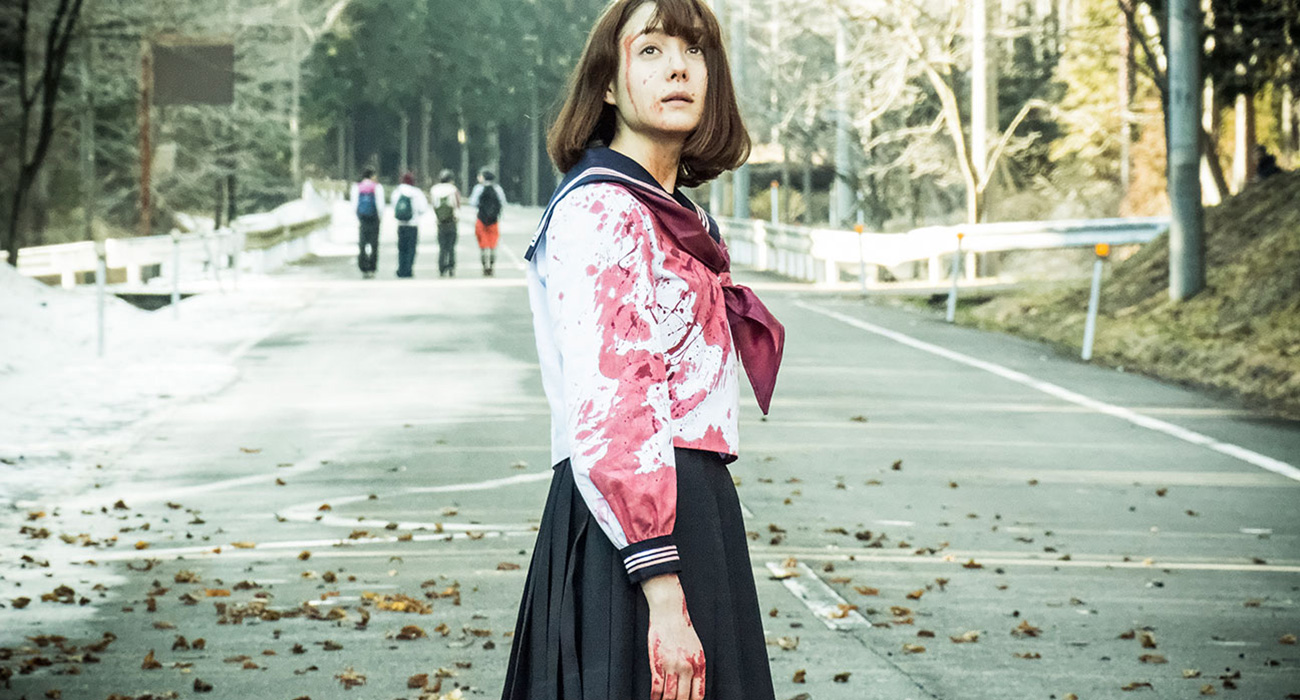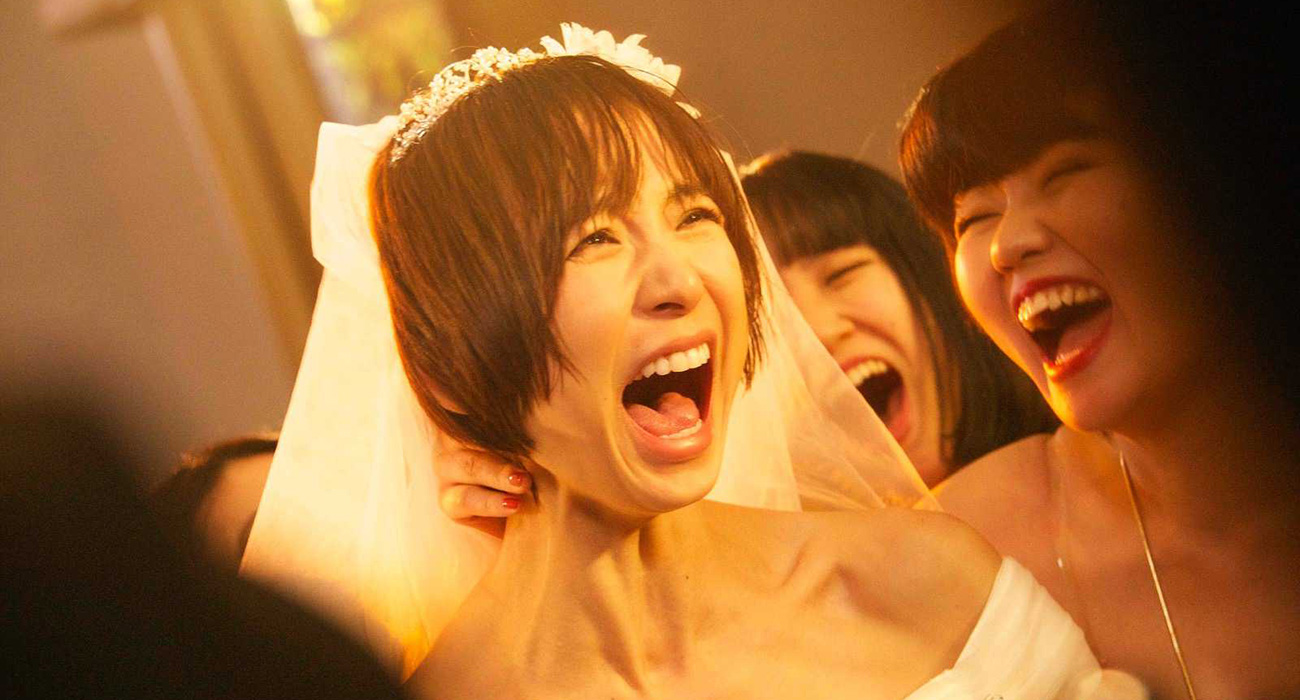DISCLAIMER: Filmmaker Sion Sono has been accused of sexual harassment and abuse by several actresses in Japan’s film industry. To learn more about these allegations, please read this report by Variety and visit this Twitter thread by actor Yuki Matsuzaki.
Filmed in Ether does not tolerate any form of sexual misconduct and condemn those that abuse their positions of power. In light of these allegations, Filmed in Ether will no longer produce any coverage and publicity for any of Sion Sono’s films, new and old, moving forward.
As we are an Australian-based publication, please seek out these Australian support services if news of Sono’s allegations have caused you distress.
For those new to the church of Sion Sono, Tag mightn’t be the greatest entry point. Occasionally offensive, frequently bizarre and excessively cheap with its practical and visual effects, Sono’s exploitation feature isn’t exactly friendly to first-time audiences of the maverick filmmaker. Hell, it can even test the patience of those already devoted to the brazen filmmaker, as was the case for me as it took a while for me to warm up towards the film and really engage with it.
Part of this comes down to the sudden immediacy of Tag which throws you right into the deep end early on (and to some extent, you’re left floundering in the deep end throughout most of the film) and hardly gives you time to come up for air and absorb everything going on. Then there’s Sono directorial decisions which unfortunately exploit Tag’s young women (a cast which I’ve learnt is made up former J-Pop idols and models). So what exactly changed my early stance on the film? *spoilers ahead*

In what can be considered a brilliant piece of meta-commentary that occurs in the latter portion of Tag, Sono uses his own film to call out himself as a male filmmaker while simultaneously reflecting on the role of women within the patriarchy. Though its roots are firmly entrenched in exploitation filmmaking, Tag’s feminist agenda is hard to ignore and everything preceding that particular moment of meta-commentary makes this scene — and by extension the rest of the film — all the more powerful and well-earned.
When we’re first introduced to the world of Tag, one of its most noticeable features is that the world of the film is literally inhabited only by women. Early in the film, many of these young women are mysteriously killed off in a bus on the way to school. The only person to survive is Mitsuko (Reina Triendl) who fearfully runs for her life and continues to do so once she encounters mysterious forces who’ve begun to massacre her classmates. Along the way, Mitsuko mysteriously transforms into other women — Keiko (Mariko Shinoda) a bride-to-be and Izumi (Erina Mano) a star track athlete. Their roles, as well as Mitsuko’s own, become much clearer later down the line.

When Mitsuko earns her freedom and escapes the nightmare of her world, it is short-lived. All the gore, blood and carnage of the first half of the film feel insignificant to what comes next. Transported into the literal “male world”, Mitsuko is bewildered by her surroundings. Sono plays the scene not for laughs or for drama but with sheer unsettling horror. It’s a deeply rattling experience as we’re presented with a scenario that’s even more worrisome than the last. We’re unsure of what will happen to Mitsuko in this new environment now that she has become aware of the male world and begins to question her place in it. This especially becomes clear once Mitsuko, and the audience, see some men staring at official promotional material for Tag within the film. Sure, it’s not exactly subtle but sometimes the most obvious route is the best way to go about things, especially in a film like Tag that’s already as loud as it can be.
Sono’s decision to cast former idols and models therefore becomes clear as does his intentional choice to have these women embody a particular “role” that men lust over. The schoolgirl, the bride, the skimpy athlete — each of these “types” serve as configurations of women that men have programmed in their eyes as their own sexual playthings. But these women are not “designed” to entertain which Mitsuko emphatically states repeatedly in Tag’s increasingly surreal final scenes.

In the original source material that Sono’s film is based on, only those with the surname ‘Sato’ are targeted and killed. By changing its focus to young women, Sono’s message becomes clear and direct. Tag might not be as empowering for young women as one might hope it to be but presenting the plight of women within the patriarchy in such bleak fashion is effective in other ways. By forcing Tag’s presumably male demographic to truly assess the media they consume and question the decisions behind its creation, the film makes them look inward and question why they would even want to see or interact with media that objectifies women.
Others however might not see it this way and I don’t doubt that Tag will divide and draw the ire of many. I do think that some of the things Sono does in order to achieve his message might be a bit unnecessary but its latter half is where the film truly shines. Sono’s Tag is indeed one of the most bizarre and bleak films about women and their coming-of-age that I’ve seen in recent memory. On the craziness factor, it’s perhaps just as strange (if not moreso) as the charmingly weird world of House / Hausu. It mightn’t be as immediately great as Sono’s other famous efforts like his four hour opus Love Exposure, Guilty of Romance or Why Don’t You Play in Hell? but this is one film that nevertheless packs a pretty mean punch by merging social commentary, exploitation and horror all into one — it’s the only way Sono knows how.
